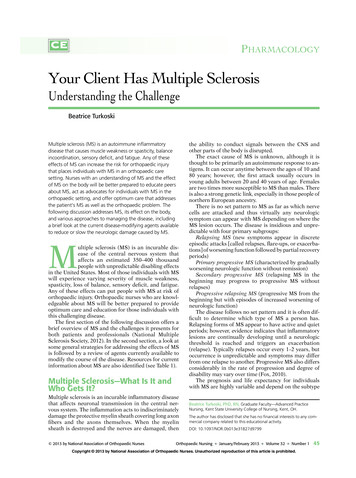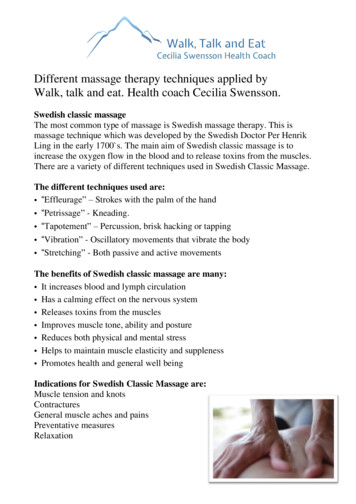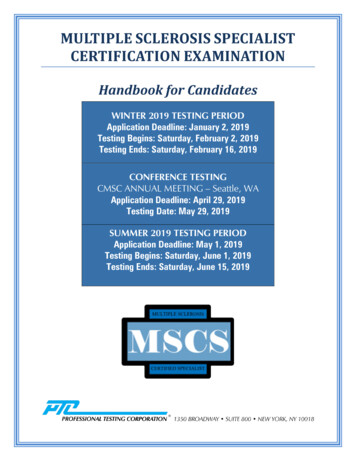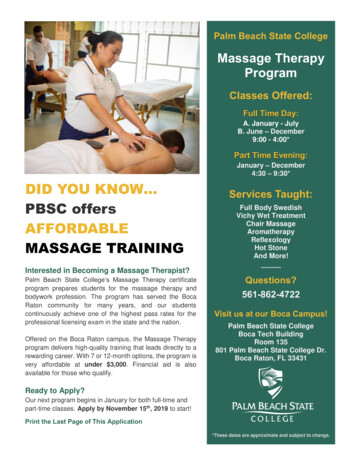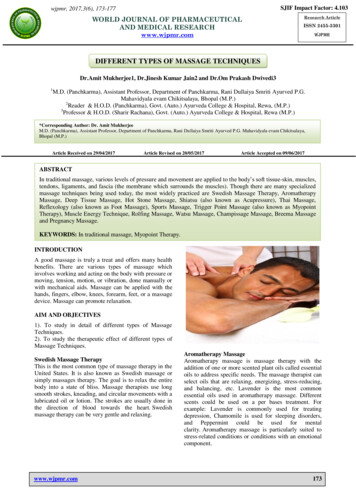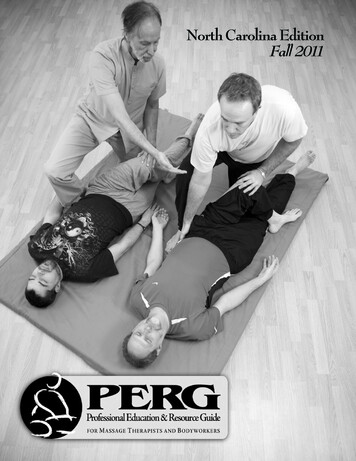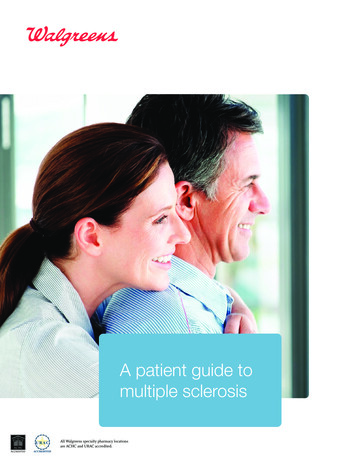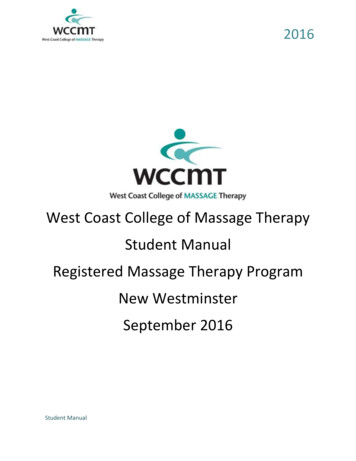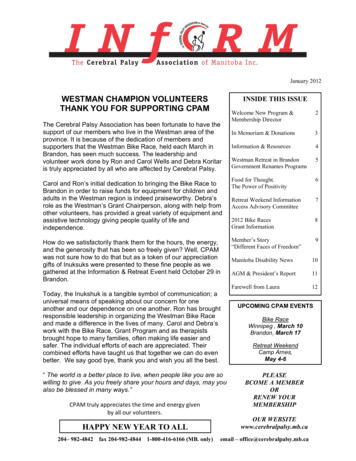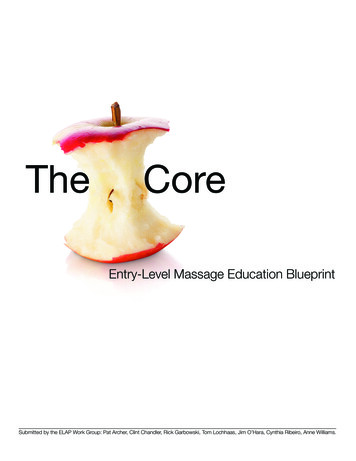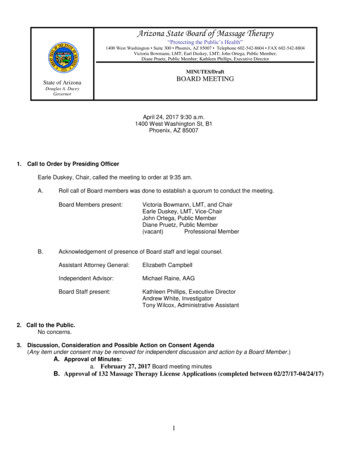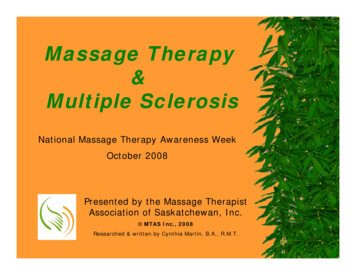
Transcription
Massage Therapy&Multiple SclerosisNational Massage Therapy Awareness WeekOctober 2008Presented by the Massage TherapistAssociation of Saskatchewan, Inc. MTAS Inc., 2008Researched & written by Cynthia Martin, B.A., R.M.T.
IntroductionThis presentation is a brief about thebenefits of massage therapy forindividuals living with MultipleSclerosis.
Our Body’sNervousSystem:The Central NervousSystem consists of thebrain and the spinalcord.The Peripheral NervousSystem are all the nerves(neurons) that branch offthe spinal cord to allparts of the body.
Multiple SclerosisSymptomsMS affects the coating on the nerves (neurons) inthe central nervous system. Damaged neurons canproduce these and other symptoms:muscle weakness/atrophy (hypotonicity) paralysis muscle tremors increased muscle tone (hypertonicity) &exaggerated reflexes/spasticity joint stiffness difficulty with walking or balance constipation depression/anxiety fatigue.
Massage TherapyMassage therapy improves an individual’s generalhealth, speeds healing of soft tissue, muscle or jointinjuries, alleviates pain, reduces symptoms of someillnesses/conditions and reduces stress.11Field,Tiffany; Hernadez-Reif, Maria; Diego, Miguel; et al. “Cortisol Decreasesand Serotonin and Dopamine Increases Following Massage Therapy” (2005).International Journal of Neuroscience, 115,10, 1397-1413.
Massage Therapy & MS“Although a small number of people reportedexperiencing negative effects from CAM% (5%), thevast majority perceived positive effects (72%).Therapies most often sited as beneficial weremassage therapy, acupuncture and cannabis.The most common reasons for using CAM were toimprove health (68%) [and] to lessen thesymptoms of MS (61%) .”2%Complementary & Alternative Medicine (CAM)2 Page,Stacey A., Verhoef, Marja J., Stebbins, Robert A., et al, (2003). “TheUse of Complementary and Alternative Therapies by People with MultipleSclerosis”, Chronic Diseases in Canada, Vol. 24 No. 2/3.
Massage TherapyConsiderations:Massage therapy results depend ona person’s general health, diet, fluidintake and usual physical activity.Duration of MS symptom reliefdepends upon the stage and severityof the illness.It is recommended a MS clientreceive consent from his or herphysician prior to receiving massagetreatment.A Registered Massage Therapist(RMT) can best determine thefrequency and length of treatmentsto achieve results best for the client.
Treating MS symptoms:Muscle atrophy/Paralysis(muscle weakness)To treat muscle weakness or paralysis, the primarygoal is to maintain the integrity of muscle tissue. Massage therapy improves the circulation ofoxygenated, nutrient rich blood to muscles andother tissues. Swelling (edema) is common with atrophy orparalysis. Specific light massage techniquesare designed to move fluid from the area backinto the body’s general circulation.
Muscle hypertonicity/Tremors/Spasticity(increased muscle toneand exaggerated reflexes) Various massage techniques are designedto reduce abnormal muscle tone, relievepain, increase circulation and musclelength to reduce spasm. Other massage strokes are designed tosedate the nervous system or local peripheralnerves. This temporary sedation of nerves willreduce their exaggerated stimulation ofmuscle fibers
Joint stiffness Massage to increase blood circulation inmuscles surrounding a stiff joint will alsocreate more pliable tendons, ligamentsand other connective tissue. More pliabletissue means easier movement in a joint. Particular stretchesand exercises maybe needed tomaintain a joint’srange of motion andflexibility betweenmassage therapyappointments.
Difficulty with walking or balance Not only do we have receptors in our body fortemperature and pressure, there are sensorscalled proprioreceptors that tell our brain thedirection and speed a body part is moving.Massage therapy can stimulateproprioreceptor function. Normal or nearnormal muscletone realizesbetter control ofjoints, whichhelps walkingand balance.
Constipation Specific, gentle abdominal massagehelps encourage movement of stored gasand stools. Reducing emotionalstress and physicalmuscle tension alsohelp relievegastrointestinalproblems.
Depression/AnxietyCaring, compassionate touch has a physiological effecton neurotransmitters, stress hormones and self-esteem. “The massage group [in this study] had lower anxiety andless depressed mood immediately following the massagesessions, and by the end of the study they had improvedself-esteem, better body image and image of diseaseprogression, and enhanced social functioning.”3 The results [of this study] suggest that massage therapymay increase the self-efficacy of clients with MS,potentially resulting in a better overall adjustment to thedisease and an improvement in psycho-emotional state.43Hernadez-Reif,M., T. Field & H. Theakston (1998). “Multiple Sclerosis Patients Benefit fromMassage Therapy”, Journal of Bodywork and Movement Therapies, 2, 168-174.4 Finch, Paul, Becker, Pauline (2006). “Changes in the Self-efficacy of Multiple SclerosisClients Following Massage Therapy”, Journal of Bodywork and Movement Therapies, 11,267-272.
Fatigue Gentle, but vigorous massage strokes willstimulate peripheral nerves, helping toalleviate some fatigue. Another approach is to use soothingmassage strokes to promote relaxationand enhance the client’s quality of sleep. The cause of a client’s fatigue willdetermine the technique used by theRegistered Massage Therapist.
Conclusion: There is no specific massage therapy protocol forpeople living with MS. Each individual must beassessed and treated in accordance to their uniquesymptom presentation. Massage therapy will not change the course of MS. Research has shown that massage therapy can playan effective role in maintaining one’s general health. Research also shows that many people with MS rely onmassage therapy for symptom relief and stressreduction. Caregivers of people with MS will also benefit frommassage therapy.
Contraindications:Applications of cold or heat during a massage treatmentmay worsen symptoms. So will an environment that is toowarm.Massage therapy is not used when severe inflammation(acute episodes) is present.Over-stimulation of nerves might result in muscle spasms.Areas without sensation require very light effleurage only.Osteoporosis caused by steroid medication requiresdifferent massage techniques than usual.Massage therapy is never used when a client has a fever oran infection.
What is a RMT? A Registered Massage Therapist (RMT), ishealth professional trained to assess and treatsoft tissue (ligaments, tendons, fascia),skeletal muscle and joint dysfunction. Only members of the Massage TherapistAssociation of Saskatchewan (MTAS) areallowed to use the designation “RMT” or callthemselves a Registered Massage Therapist. “Remedial massage therapist” is not anaccepted term. ”Licensed massage therapist” is not anacceptable term because the practise ofmassage is not currently legislated inSaskatchewan.
Receive MassageTreatment from a RMTCurrently massage therapy is not legislated inSaskatchewan. That means the public has little protectionfrom under qualified or incompetent people providingmassage.Members of the Massage Therapist Association ofSaskatchewan (MTAS) have to prove their qualificationsand ensure their competency with continuing education.Ask for a MTAS Registered Massage Therapist. If indoubt, ask to see the therapist’s current MTASmembership wall certificate or wallet card.
MTAS MembersProtect Clients: Members follow a detailed Code of Ethics,Standards of Practice and must maintain clienttherapist confidentiality.Mandatory malpractice and liability insurance is arequirement of membership. Certificates inStandard First Aid & CPR. Level ‘C’ are alsomandatory.If there is a problem with the massage treatmentyou received or with the RMT, the client has a wayto address it. MTAS has a well developedComplaints & Investigation system that is engagedonce a client signs a form to register a complaint.
How to Find a MTASRegistered MassageTherapist:Phone the MTAS office in Saskatoon: 384-7077.Ask for a list of RMTs working in or near yourcommunity.Go to www.saskmassagetherapy.com. There is atab on the home page called “Find a massagetherapist”.Check your local Yellow Pages under “massagetherapist”. RMTs usually state they are members ofMTAS.
National MassageTherapy AwarenessWeekThis ‘Week’ was created to increase publicknowledge of massage therapy and itsusefulness in treating everyday aches & pains,injuries, illnesses and stress. Many people enjoymassage therapy as regular ‘maintenance’ fortheir body and mind.National Massage Therapy Awareness Week iscelebrated across Canada and in the UnitedStates.
Resources:Finch, Paul, Becker, Pauline (2006). “Changes in the Selfefficacy of Multiple Sclerosis Clients Following MassageTherapy”, Journal of Bodywork and Movement Therapies,11, 267-272.Field, Tiffany; Hernadez-Reif, Maria; Diego, Miguel; et al.“Cortisol Decreases and Serotonin and DopamineIncreases Following Massage Therapy” (2005).International Journal of Neuroscience, 115,10, 1397-1413.Hernadez-Reif, M., T. Field & H. Theakston (1998).“Multiple Sclerosis Patients Benefit from MassageTherapy”, Journal of Bodywork and Movement Therapies,2, 168-174.MacDonald, Gayle. Massage for the Hospital Patient andMedically Frail Client, Philadelphia: Lippincott Williams &Wilkins, 2005.
Page, Stacey A., Verhoef, Marja J., Stebbins, Robert A.,et al, (2003). “The Use of Complementary and AlternativeTherapies by People with Multiple Sclerosis”, ChronicDiseases in Canada, Vol. 24 No. 2/3.Premkumar, Kalyani. Pathology A to Z: A Handbook forMassage Therapists. Calgary: VanPub Books, 1996.Vanderbilt, Shirley, “Searching for Comfort: AlternativeTherapies and Multiple Sclerosis”, Massage & Bodywork,August-September 2004.Werner, Ruth. A Massage Therapist’s Guide to Pathology.3rd ed. Philadelphia: Lippincotte Williams & Wilkins, 2005.Yates, John. A Physician’s Guide to Therapeutic Massage.3rd edition. Toronto: Curties-Overzet Publications, 2004.
Massage TherapistAssociationof Saskatchewan, Inc.16-1724 Quebec AvenueSaskatoon, SK. S7K 1V9(306) 384-7077 or (306) 384-7175 faxmtas@sasktel.netwww.saskmassagetherapy.comLori Green, Executive DirectorJayne Little, Executive Assistant
Massage Therapy 1Field, Tiffany; Hernadez-Reif, Maria; Diego, Miguel; et al. "Cortisol Decreases and Serotonin and Dopamine Increases Following Massage Therapy" (2005). International Journal of Neuroscience, 115,10, 1397-1413. Massage therapy improves an individual's general health, speeds healing of soft tissue, muscle or joint
